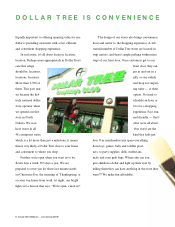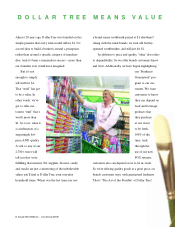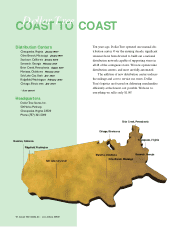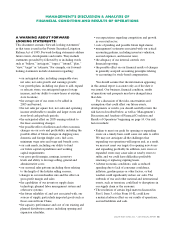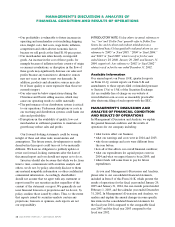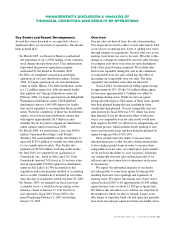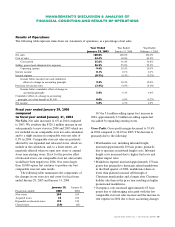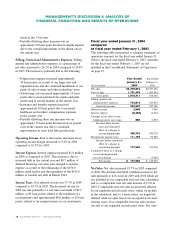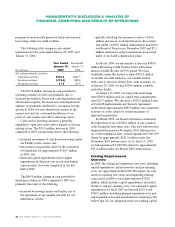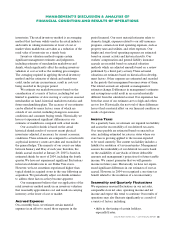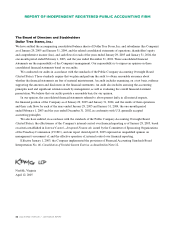Dollar Tree 2004 Annual Report Download - page 20
Download and view the complete annual report
Please find page 20 of the 2004 Dollar Tree annual report below. You can navigate through the pages in the report by either clicking on the pages listed below, or by using the keyword search tool below to find specific information within the annual report.
16 DOLLAR TREE STORES, INC. • 2004 ANNUAL REPORT
While our newer, larger stores have lower sales per square
foot than older, smaller stores, they generate higher sales
and operating income per store and create an improved
shopping environment that invites customers to shop
longer and buy more. When our larger stores become the
majority of our store base, which we expect to occur by
the end of 2005, we believe our net sales per square foot
will begin to rise.
We must control our merchandise costs, inventory
levels and our general and administrative expenses.
Increases in these expenses could negatively impact our
operating results because we cannot pass on increased
expenses to our customers by increasing our merchandise-
selling price above the $1.00 price point.
Our point-of-sale technology provides us with
valuable sales information to assist our buyers and to
improve merchandise allocation to the stores. We
believe that it will enable us to better control our
inventory, which will result in more efficient distribution
and store operations. During the first half of fiscal 2004,
we completed the rollout of our point-of-sale systems to
most of our stores. Due to the fact that this rollout is now
substantially complete, we expect our depreciation expense
as a percentage of sales to be about flat for fiscal 2005 as
compared to fiscal 2004.
Our plans for fiscal 2005 operations anticipate
comparable store net sales increases of flat to slightly
positive, net sales in the $3.4 to $3.5 billion range and
diluted earnings per share of $1.77 to $1.87. We also
expect a shift in the seasonality of our earnings in 2005.
For example, the Easter selling season is 16 days shorter
in the current year, impacting the first quarter of 2005,
and there is an extra day between Thanksgiving and
Christmas, which will impact the fourth quarter as
compared to the prior year.
We recognized a one-time non-cash, after-tax
adjustment of approximately $5.7 million, or $0.05 per
diluted share, in the fourth quarter of 2004 to reflect
the cumulative impact of a correction of our accounting
practices related to leased properties. Of the afore-
mentioned amount, approximately $1.2 million, or
$0.01 per diluted share, related to the current year. This
adjustment was made in light of the views, of the Office
of the Chief Accountant of the Securities and Exchange
Commission, expressed in a letter of February 7, 2005, to
the American Institute of Certified Public Accountants
regarding the application of generally accepted
accounting principles to operating lease accounting
matters. Consistent with industry practices, in prior
periods, we had reported straight-line expenses for leases
beginning on the earlier of the store opening date or the
commencement date of the lease. This had the effect of
excluding the pre-opening or build-out period of our
stores (generally 60 days) from the calculation of the
period over which we expense rent. In addition, amounts
received as tenant allowances or rent abatements were
reflected in the balance sheet as a reduction to store
leasehold improvement costs instead of being classified
as deferred lease credits. The adjustment made to correct
these practices does not affect historical or future net cash
flows or the timing of payments under related leases.
Rather, this change affected the classification of costs on
the statement of operations and cash flows by increasing
depreciation and decreasing rent expense, which is
included as cost of sales. In addition, fixed assets and
deferred liabilities increased due to the net cumulative
unamortized allowances and abatements. We believe that
the new lease accounting practices will have a $0.01 per
diluted share effect on 2005 earnings.
MANAGEMENT’S DISCUSSION & ANALYSIS OF
FINANCIAL CONDITION AND RESULTS OF OPERATIONS


